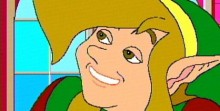Theory: The CD-i games are on the timeline
Posted on December 14 2013 by Maanav Goyal
 There are three games that most fans of the series tend to leave in the past. Those are the CD-i games. The CD-i games were a three game series created for the Phillips CD-i after a partnership between Phillips and Nintendo. From this, three Zelda games were created for the CD-i. The games were called Link: The Faces of Evil, Zelda: The Wand of Gamelon and Zelda’s Adventure. The games were released highly negative reviews, and many years later, were heavily parodied on YouTube. I am here to show that those three games do fit in on the official timeline, just hidden by Nintendo in shame. Hit the jump to see where they fall on the timeline!
There are three games that most fans of the series tend to leave in the past. Those are the CD-i games. The CD-i games were a three game series created for the Phillips CD-i after a partnership between Phillips and Nintendo. From this, three Zelda games were created for the CD-i. The games were called Link: The Faces of Evil, Zelda: The Wand of Gamelon and Zelda’s Adventure. The games were released highly negative reviews, and many years later, were heavily parodied on YouTube. I am here to show that those three games do fit in on the official timeline, just hidden by Nintendo in shame. Hit the jump to see where they fall on the timeline!
Link: The Faces of Evil and Zelda: The Wand of Gamelon are brother and sister games, following the same art style and over all gameplay style. But as you can tell, they have a major difference, the protagonist of the games. The Faces of Evil, as the name suggests, features Link as the main character of the game, meanwhile The Wand of Gamelon features Zelda as the character the player controls. Similarly, Zelda is the protagonist of Zelda’s Adventure. As simple as it seems, this creates a mini timeline in which the CD-i games follow.
In The Faces of Evil Link is obviously sent to complete the quest. In The Wand of Gamelon Link goes missing on a quest, and Zelda decides it is up to her to go find Link. Similar to The Wand of Gamelon, in Zelda’s Adventure Link does go missing on a quest, and Zelda must go find him. This leads to a timeline created following simple logic. In The Wand of Gamelon, Zelda brings it upon herself to save Link. In the next CD-i game, Zelda’s Adventure, is not just morally told to save them, but instead is told to save Link.
This creates an order to the games for one reason, Zelda has shown she can help. In The Faces of Evil, Link is sent as he has been many times before. In The Wand of Gamelon, Link goes missing, so Zelda decides to save him. After that, it is revealed that Zelda has the ability to be a hero. Finally, Zelda’s Adventure happens, and Zelda is told to go save Link. Now that this order has been established, we can see where the three fall on the official timeline.
These three games fall under the fallen Link timeline, after the original two Zelda games. There is a fair reason for this. It has been accepted at this point that Ganon will continue to return. In almost every game in that branch of the timeline, Ganon has been revived, and eventually, after the events of Zelda II, Ganon starts becoming a smaller threat.
The shrinking threat could be for a simple reason. It is the same Ganon and the same Link in the three CD-i games and the two original NES games. This Link is the same Link in the CD-i games, as the CD-i Link states in The Faces of Evil, “I just wonder what Ganon’s up to.” This implies the fact that he knows Ganon, and knows of his ways, and how he does return constantly. It would be dangerous for Link to have said this, unless he said it under one condition, he has faced Ganon, making it highly possible that he is the same Link.
You may disagree with this, and say, “What about the child Link timeline? The games could easily fit in there!” Well I have evidence going against that! At the end of Four Sword Adventures, Ganon is sealed up. In every Zelda game in which Ganon is sealed, he doesn’t return for generations. In the games he is killed, he can be resurrected within the same generation, as seen with the original two Zelda games, which do feature the same Link. Link wouldn’t know who Ganon was if this was in the child Link timeline, only leaving the possibility that it is in the fallen Link timeline.
But let us know what you think about this theory! Do you agree with it? Is it even worth mentioning? Let us know in the comments below!
Thanks for reading!



